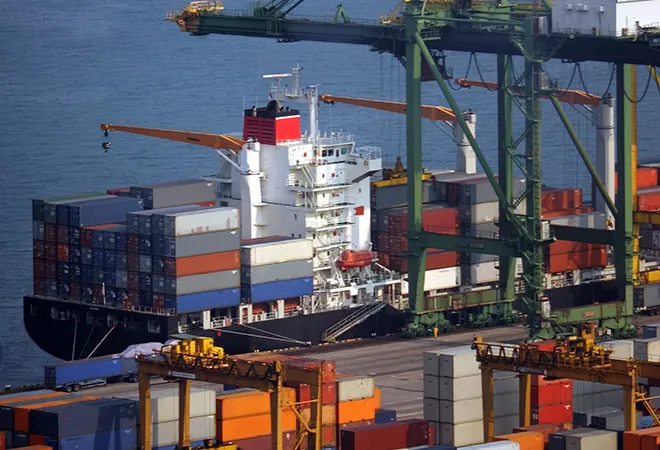 This piece is part of the essay series, Strategic High Tide in the Indo-Pacific: Economics, Ecology, and Security.
This piece is part of the essay series, Strategic High Tide in the Indo-Pacific: Economics, Ecology, and Security.
The Indo-Pacific region is an important one for three reasons. First, three of the world’s largest economies, i.e., the US, China, and Japan are present, and the region accounts for 60 percent of global GDP. Second, 60 percent of global maritime trade occurs through the waters in the region. Finally, the fastest growing emerging economies—Cambodia, India, and Philippines—are also from the region. Economic growth may push many of these economies into the upper-middle-income category and lift billions out of poverty. Trade is critical to achieve this vision for the region. The questions that need to be asked are: a) What are the primary impediments hindering trade in the region? Is the answer enhanced bilateralism nurturing co-dependencies or is it more integrated multilateralism? b) Can enhanced economic cooperation contribute towards economic revival of the region? This article tries to answer these questions.
Three of the world’s largest economies, i.e., the US, China, and Japan are present, and the region accounts for 60 percent of global GDP.
Trade in the Indo -region
The importance of the Indo-Pacific region to global GDP and maritime trade reflects a shift in the world economic centre of gravity to the Indo-Pacific. This has been driven by factors like the rise of global value chains (GVCs) and the importance of ‘Factory Asia’. In the aftermath of COVID-19, recovery was led by the East Asian countries. The increasing protectionism in certain countries during COVID-19 and the aftermath of the China-US trade war has led to the reassessment of options for countries and calls for supply chain resilience.
Barriers to greater commerce and connectivity
Many countries had instituted barriers and export restrictions due to COVID-19. Some of these barriers may have been dismantled but overcoming these barriers are key to more trade in the region. The factors affecting GVC integration include: Regional trade agreements; investment barriers to multinational corporations; infrastructure development; speed and flexibility of movement of physical goods and information; effectiveness of legal and regulatory systems; efficiency of services; developing a skilled workforce; friendliness of the business climate; and capacity of domestic firms (often SMEs) to contribute to the supply chain. Administration of borders, market access barriers, and transport logistics are some other factors that impact the integration of GVCs.
Overcoming the barriers
Policy matters for logistics performance and operation and is the key for creating a comprehensive and conducive environment for logistics services. International connectivity can be improved by:
- Tighter backward and forward links within GVCs
- Securing the flow of inputs and outputs
- Creating efficient links with flow of inputs and outputs
- Reducing the thickness of the border
Economic cooperation in the Indo-Pacific
China is ASEAN’s largest trading partner, and since the pandemic, ASEAN is also China’s largest trading partner. Therefore, as noted earlier, regional integration and global value chains are critical, especially in a region like the Indo-Pacific which has led trade recovery in the world. Recognising the importance of imports to boost exports can help recover some external demand and boost growth. Resilience of supply chains is also vital. Organisation for Economic Co-operation and Development (OECD) identifies the ways in which supply chains can be made more resilient in the short run: This includes improving transparency and trade facilitation measures to lower barriers to trade and investment, especially for essential services. In the long run, however, diversification can help. Above all, at the international level, only greater cooperation can help. For the Indo-Pacific region, cooperation amongst the countries can lead to economic gains.
Organisation for Economic Co-operation and Development (OECD) identifies the ways in which supply chains can be made more resilient in the short run.
Some recent initiatives, include:
Conclusion
The Asian Development Bank (ADB) estimated that to keep up with economic growth and climate change, the region’s infrastructure development would require an investment of US $1.7 trillion annually until 2030. Digital infrastructure including e-commerce platforms, cybersecurity measures, distance learning protocols, legal frameworks reforms, e-government services, and increasing local technical cooperation will also be required. The primary impediments hindering trade in the region can be overcome by greater cooperation. It is also important to align trade and foreign policy to reap benefits of regional integration. There has been a revival of the Quadrilateral Security Dialogue (Quad), which clearly states the shared vision of Australia, India, Japan, and the United States for the Indo-Pacific. Enhanced economic cooperation is the key towards economic revival for the region, while growth is needed to push countries to upper-income status and lift people out of poverty in the region.
The views expressed above belong to the author(s). ORF research and analyses now available on Telegram! Click here to access our curated content — blogs, longforms and interviews.



 This piece is part of the essay series,
This piece is part of the essay series,  PREV
PREV


